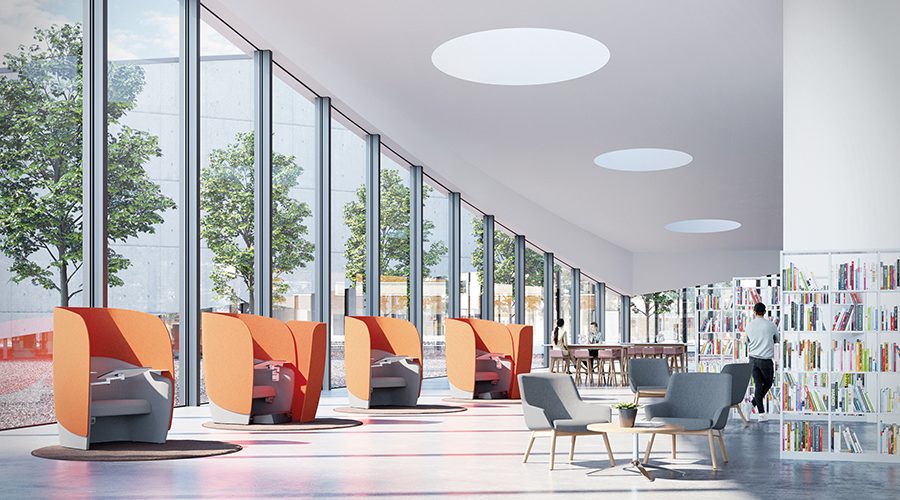From early years, primary and secondary, to further and higher education facilities, every learning establishment has a duty to create the best possible environment for its pupils and students. Ensuring that future generations are well educated and have the skills they need to prosper is paramount; not only for their own future but for the future of our nation too, says Eve Fitzhenry, Head of Marketing at Boss Design.
Boss Design
The interior layout including seating and furniture are crucial in education establishments. Indeed, when the University of Salford conducted research on the influence of design on students’ learning and performance, it discovered that colour could increase a student’s ability by as much as 12%. Dynamic, modern learning spaces are key to helping students flourish and to making learning more inspiring, engaging and even fun. Take colleges that offer a travel and tourism classroom with aeroplane seats and a modern hair and beauty salon for health and beauty studies. These are just some of the many creative designs that are starting to appear in learning environments.
When designing a learning environment, however, it’s important to understand that learning is about the development of ideas, application of information, contextualisation, and collaboration with others – it’s not just about filling students’ heads with information. It’s also about their personal development and the ability to achieve headspace. Therefore, it’s important to provide a balance of surroundings to allow them to learn in new ways. Designers can then choose the appropriate furnishings and upholstery to further help students study better.
At Boss Design, we have identified four key types of learning environments; learner-centred, collaborative, focused and assessment. Let’s take a closer look to understand how each learning environment would benefit from a balanced design.
Learner-centred: traditional classrooms with rows of desks arranged in front of a tutor are starting to take a back seat. Now, it’s commonplace to see more relaxed and collaborative learning settings. Team-based environments are common here too. These may consist of circular tables or soft seating at which teams of students work collaboratively with the instructor. Of course, technology plays a key role in this environment. Rather than having a single projector at the front of the room, wireless networking enables everyone to act as a presenter, either projecting work from their own device or sharing it remotely with others.
Collaborative: although some of these settings may still resemble the traditional classroom, the processes involved and the culture they represent are very different. Now, settings are emerging that create positive feedback loops of development for individuals that use them to collaborate. Mistakes or a lack of understanding are treated as a chance for individuals and the group to improve, and this, in turn, encourages personal development and the formation of new ideas. The design of the room should emphasise that contributions of all members of a group are valid, and not just the instructor. Furniture that fosters inclusivity, group cohesion and the sharing of knowledge are vital for this environment. Those that provide a base for the day
or fulfil break-out area needs are also popular.
Focused: everybody needs time and space to acquire their own skills and develop the knowledge to support their ideas. Well-designed libraries and private rooms remain crucial for these tasks, helping to minimise the interruptions of neighbours or devices, but it’s not just about noise distraction, it’s also about privacy. That’s why the demand for private work booths and soft seating that offer superior visual, acoustic, and territorial privacy is growing rapidly. This type of furniture enables students to focus without distractions. The intelligent use of screens and partitions also help provide the right balance of privacy and interaction. Small freestanding acoustic pod systems also provide the perfect breakout space for students to rest and escape from a busy learning environment. Whether working in solitude, focusing on a concentrated task, or working as a small group, they offer the intimacy and privacy that is vital for modern methods of learning.
Assessment: formative assessments are usually ongoing and require upholstery and furniture that can facilitate feedback for students on a one-to-one basis. Soft seating that offers an intimate, comfortable and private environment is a popular choice in this scenario. On the other hand, summative assessments require more formal settings for tests and exams to take place.
There’s never been a better opportunity to design and create outstanding learning spaces. It’s not just about products. Good design is all about finding the right balance of furniture and settings that clearly indicate to students who best suit certain activities. Each space should acknowledge that students learn in different ways, and, therefore, a balance of learning spaces in which studying can take place will help bridge the gap between the digital and physical worlds
of learning.










